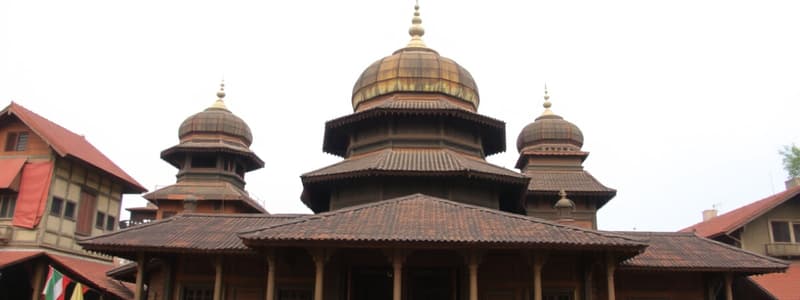Podcast
Questions and Answers
What is the primary regions where Bengali is spoken?
What is the primary regions where Bengali is spoken?
- Nepal and Bhutan
- Bangladesh and West Bengal (correct)
- Pakistan and Assam
- Delhi and Mumbai
What is the sentence structure of the Bengali language?
What is the sentence structure of the Bengali language?
- Subject-Verb-Object (SVO)
- Verb-Subject-Object (VSO)
- Object-Subject-Verb (OSV)
- Subject-Object-Verb (SOV) (correct)
Who is a prominent figure in Bengali literature known for winning the Nobel Prize?
Who is a prominent figure in Bengali literature known for winning the Nobel Prize?
- Rabindranath Tagore (correct)
- Bankim Chandra Chatterjee
- Kazi Nazrul Islam
- Satyajit Ray
Which of the following is a major Bengali festival?
Which of the following is a major Bengali festival?
What is the script used for writing Bengali?
What is the script used for writing Bengali?
What is a significant challenge faced by Bengali speakers?
What is a significant challenge faced by Bengali speakers?
Which of the following is a characteristic of Bengali phonetics?
Which of the following is a characteristic of Bengali phonetics?
Which of the following best describes Bengali's influence on global culture?
Which of the following best describes Bengali's influence on global culture?
Study Notes
Overview of Bengali
- Language Family: Indo-Aryan branch of the Indo-European family.
- Primary Regions: Bangladesh and the Indian state of West Bengal.
- Speakers: Over 230 million native speakers, making it the seventh most spoken language in the world.
Historical Context
- Ancient Roots: Evolved from Sanskrit; has influences from Persian, Arabic, and English.
- Literature: Rich literary tradition dating back to the 8th century. Significant figures include Rabindranath Tagore (Nobel Laureate) and Kazi Nazrul Islam.
Dialects
- Standard Bengali: Based on the Kolkata dialect.
- Regional Variations: Includes Sylheti, Chittagonian, and other local dialects.
Script and Phonetics
- Script: Bengali script, a syllabic alphabet derived from Brahmi.
- Phonetics: Characterized by a range of vowels and consonants, with distinct nasal sounds.
Cultural Significance
- Festivals: Major cultural events include Durga Puja, Pohela Boishakh (Bengali New Year).
- Cuisine: Known for rice, fish, and sweets; famous dishes include Hilsa fish curry and Rasgulla.
Grammar and Syntax
- Sentence Structure: Subject-Object-Verb (SOV) order.
- Nouns and Pronouns: Gender-specific, with singular and plural forms.
- Verbs: Conjugation based on tense, aspect, and mood.
Influence and Global Presence
- Diaspora: Significant Bengali-speaking communities in the UK, USA, Middle East, and Southeast Asia.
- Cultural Exchange: Influences in music (Baul), dance, and cinema (Bollywood and Tollywood).
Modern Developments
- Digital Presence: Increasing use of Bengali in digital platforms, social media.
- Language Policy: Official status in Bangladesh; recognized in Indian states like West Bengal and Tripura.
Challenges
- Dialectal Variations: Differences in pronunciation and vocabulary can lead to communication issues.
- Literacy Rates: Ongoing efforts to improve literacy and education among Bengali speakers, especially in rural areas.
### Overview of Bengali
- Bengali is an Indo-Aryan Language part of the Indo-European family
- Over 230 million native speakers making it the seventh most spoken language in the world
- Primarily spoken in Bangladesh and the Indian state of West Bengal
Historical Context
- Evolved from Sanskrit.
- Notable influences include Persian, Arabic, and English.
- Bengali boasts a rich literary tradition that dates back to the 8th century, featuring notable writers like Rabindranath Tagore and Kazi Nazrul Islam, who have left an enduring legacy on Bengali literature and culture.
Dialects
- Standard Bengali has its roots in the Kolkata dialect, often serving as a unifying language.
- Regional variations include Sylheti, Chittagonian, and many other local dialects.
Script and Phonetics
- Uses the Bengali script, a syllabic alphabet derived from Brahmi.
- Bengali phonetics is characterized by a variety of vowels and consonants, including distinct nasal sounds, contributing to the language's unique rhythm and melody.
Cultural Significance
- Durga Puja and Pohela Boishakh (Bengali New Year) are significant cultural events.
- Food plays a prominent role. Notable dishes include Hilsa fish curry and Rasgulla.
Grammar and Syntax
- Follows the subject-object-verb (SOV) sentence structure.
- Gender-specific nouns and pronouns with singular and plural forms, reflecting the influence of Sanskrit grammar.
- Verbs undergo conjugation based on tense, aspect, and mood, adding complexity and expressiveness to the language.
Influence and Global Presence
- Significant Bengali-speaking communities reside in the UK, USA, Middle East, and Southeast Asia, representing the reach of the language through migration and diaspora.
- Bengali culture has influenced music (Baul), dance, and cinema (Bollywood and Tollywood), contributing to broader cultural exchange and shared artistic expression.
Modern Developments
- Increasing use of Bengali on digital platforms and social media reflects its growing digital presence.
- Bengali holds official status in Bangladesh and is a recognized language in Indian states like West Bengal and Tripura, highlighting its significance in both countries.
Challenges
- Dialectal variations in pronunciation and vocabulary pose challenges for effective communication.
- Ongoing efforts aim to improve literacy and education among Bengali speakers, particularly those living in rural areas, addressing the gap in access to quality education.
Studying That Suits You
Use AI to generate personalized quizzes and flashcards to suit your learning preferences.
Description
Explore the rich history, dialects, and cultural significance of the Bengali language in this quiz. From its ancient roots and literary figures to the unique phonetics and scripts, gain an understanding of one of the world's most spoken languages. Test your knowledge on the vibrant traditions and regions where Bengali thrives.




